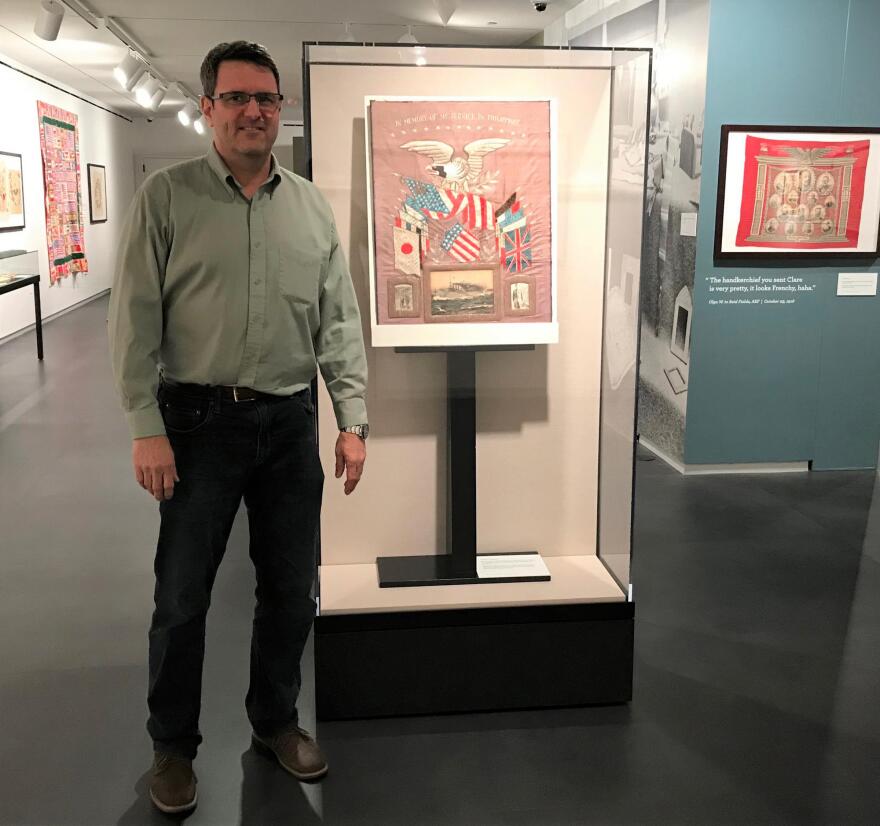In contrast to today's two ongoing wars that seem to touch only a few Americans, World War I touched everyone, killing an estimated 16 million people, both soldiers and civilians.
"It was probably the most important event in most of those peoples' lives," says Doran Cart, senior curator at the National WWI Museum and Memorial. "There was a real concern for some kind of concrete reminder that 'I was here,' or 'This is what our life was like during that time.'"
Cloth served that purpose well. It was lightweight but sturdier than paper. So people collected silk pillowcases, handkerchiefs, "silks" (embroidered postcards), and trapunto banners (a quilted cloth plaque) abroad, then sent them home to their families for safekeeping.
Corporal George Jensen, from Hastings, Nebraska, entered the war in October of 1917 with the 31st Infantry Regiment. While he was serving in the Philippines, he commissioned a trapunto.
"It was just a way for him to remember, not only him, but his family and all the people who were touched by his service," says Jensen's grandson, Roger Fitz.
"In memory of my service in Philippines" is stitched across the top of Jensen's trapunto. Several nations' flags are in the middle, and three personal service photos are framed at the bottom. It was created in Japan.

Fitz, who lives in Blue Springs, says he did not grow up looking at the piece, and his grandfather never spoke about the war. Fitz hadn't examined his grandfather's items until a few years ago when he and his mother were looking at family artifacts they could donate to the national museum.
"I think it was a way to make it personal, something that was so impersonal as war," Fitz says. "War, if you think about it, particularly WWI, is just so impersonal."
Cart says about 60 items are included in the exhibition "Color of Memory: Fabric Art of WWI." Some pieces, like Jensen's, originated abroad, in Great Britain, the Netherlands, France, Russia, Belgium, Germany, and Japan, while other pieces, like the quilts, are domestic.
Each quilt on display was made in the United States. Two Red Cross quilts were crafted, signed, and auctioned off in order to raise money. One was stitched together out of flag-themed tobacco flannels that smokers sent away for during the war, but which had nothing to do with the war itself.

Another quilt holds the signatures of 89 people, many celebrities. It was created on Armistice Day to celebrate the end of the war. Signees include Theodore Roosevelt, Charlie Chaplin, Helen Keller, Orville Wright and 41 governors.
"It's a celebrity thing. You get Eddie Rickenbacker's signature, that's pretty good," says Cart. Rickenbacker was the most successful fighter ace in WWI. Cart says he's traced the quilt, which the museum purchased from a woman in Florida, to Congresswoman Jeannette Rankin.

Rankin, a representative from Montana, was the first and only woman in Congress at the time and had voted against entering the war. When the war ended, Rankin distributed rectangles of cloth for fellow politicians and celebrities to sign in celebration. Cart says he's not sure of much else. He doesn’t know who pieced the quilt together, or why it was never completed.
Cart says the signatures don't make the quilt more valuable than anything else in the exhibition.

"I think every one of them is valuable in some form because of the story it tells," he says. "I like the little sampler by the French girl who was eight years old. It was part of her lessons and she thanked the allies for their help. That to me is just as important. It tells a story. We know who she was, that she did this."
The experiences of sailors, marines, soldiers and airmen in a conflict far from home have stayed fairly consistent over the years. Cart says he thinks servicemembers in every war have items they carry home to remember that time, so this fabric will feel familiar to any veteran.
Now that every WWI veteran is deceased, souvenirs of the war like uniforms, letters, weaponry and fabric art are the only tangible evidence that remain.
"This is our way of honoring them and remembering them and of showing their place at the time," Cart says.
"Color of Memory: Fabric Art of WWI," through September 2 at the National WWI Museum and Memorial at 2 Memorial Dr, Kansas City, Missouri 64108.
Correction: George Jensen's name was misspelled in the original version of this article.
Follow KCUR contributor Anne Kniggendorf on Twitter, @annekniggendorf.





